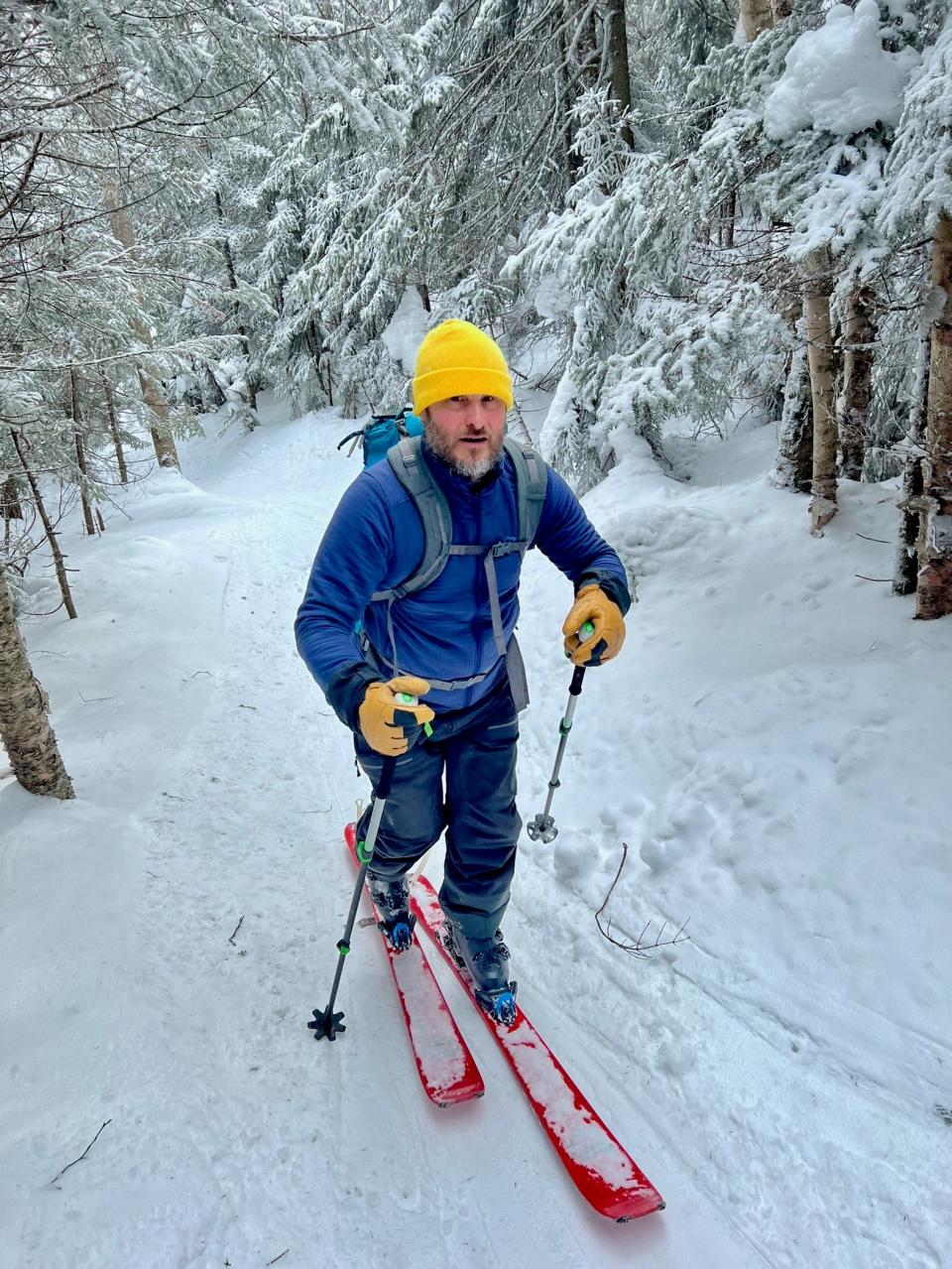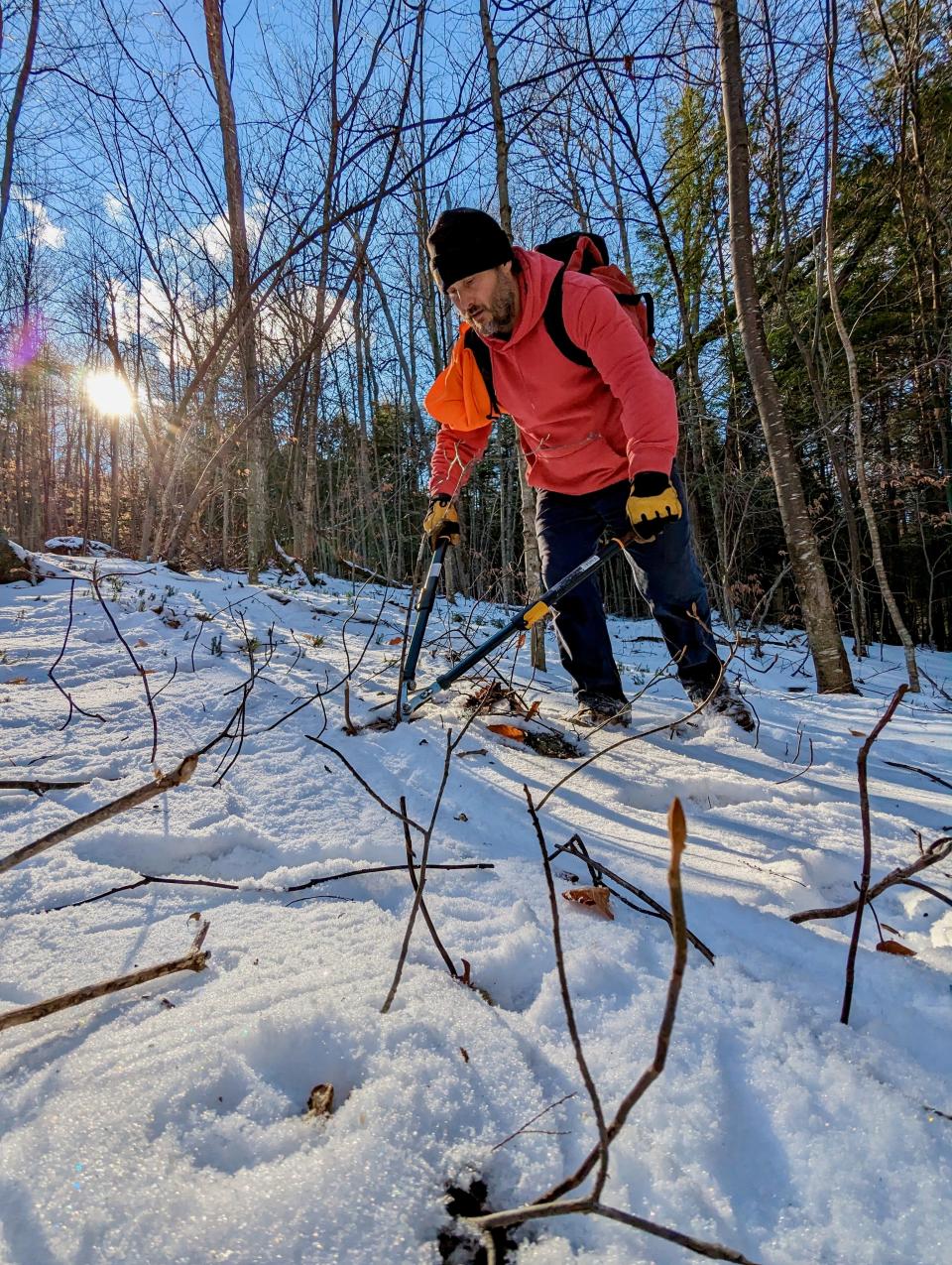Mathey at the forefront of group working to establish new trails for backcountry skiers

When the backcountry skiing boom hit northern New England, volunteers started banding together in groups like the Granite Backcountry Alliance in New Hampshire and Maine, to open up gladed areas in the woods in cooperation with local, state and federal authorities, as opposed to the wild old days of the sport that saw much illegal tree cutting and thinning, done in secret by the most hardcore practitioners of alpine touring.
Now the Bay State has its own group, the Western Mass Backcountry Alliance (WMBA), an affiliate of Vermont's Catamount Trail Association, which has in just a few years has created two top-notch backcountry skiing zones in Western Massachusetts and is looking for more sites.
The group initially also looked at clearing some of the slopes on Mount Watatic, a former ski area that straddles Ashburnham and Ashby, but opted to defer that project due to lack of parking, a complicated land ownership landscape and a sense that this popular spot was already getting too crowded on big snow days.
Working with the state
The WMBA's founder and chair, Andy Mathey, of Colrain, started the group informally in 2020 during the COVID-19 period. Mathey began attracting members and regular volunteers to do the physical work necessary to make overgrown wooded hills and mountainsides ski-able with the right equipment. Soon, the WMBA officially formed as a nonprofit, had a board of directors and was building a formal relationship and entered into memorandums of understanding with the Massachusetts Department of Conservation and Recreation (DCR).
"As long as everything's good and we're not doing any illegal cutting and we're not doing anything crazy, they're happy with us and we're happy with them," Mathay, 49, a Shiatsu massage therapist, said. "We're good to into the future."
Both of the backcountry zones occupy the flanks of what were working ski areas several decades ago and are now part of state parks, and the partnership agreement between the WMBA and DCR is based on managing most of the formerly lift-served form ski slopes back to their original footprint, with some gladed areas left for tree skiing. No heavy equipment or re-grading was needed, and when large trees have fallen or needed to be cleared, state chain saw crews have done the work. The WMBA volunteers only use human-powered tools such as hand saws and weed whackers during the trail work weekends in the fall.
The work at Beartown Backcountry is complete, while the group is still working on Berkshire Snow Basin, though it's open when there's enough snow. The group re-established three main trails for downhill skiing – Polar, Kodiak and Grizzly ‒ that were built by the Civilian Conservation Corps (CCC) in the 1930s and were part of the old Beartown Ski Resort that closed in 1964. The WMBA also cleared a dedicated uphill route, the Panda trail, and turned the old rope tow corridor into a steep chute. The group left another original trail, Sedgewick, in a mostly gladed state.
Parts of Beartown Backcountry are steep, and the whole zone offers about 800 vertical feet – a really respectable amount of terrain for backcountry skiing in southern New England and a more than decent alternative to Massachusetts' most famous backcountry skiing area, Mount Greylock and the famous Thunderbolt trail, also built by the CCC.

Berkshire Snow Basin
In contrast to Beartown, this zone is not completed, with impediments like old culverts and washed-out water bars still around. But it is manageable for careful skiers, Mathey said.
"It definitely needs some more repair, but it's ski-able. You can work around those issues, but to really make it a great managed zone and kind of the public recreation that we want to provide for the community, we want people to be able to skin up and ski down and not have safety concerns," he said.
The WMBA mitigates safety issues to some degree with its affiliation in 2022 with the Catamount Trail Association ‒ the longstanding Vermont group that maintains the backcountry ski trail that runs the length of the state starting at the Massachusetts border ‒ which provides liability insurance.
Meanwhile, Mathey said Snow Basin as a more approachable, low-angle property that is well suited for children and people just getting into backcountry alpine touring, the Alpine-Nordic hybrid that involves affixing climbing skins to the bases of your skis for the ascent. Skiers and snowboarders (who use split-boards that come apart for the uphill and bolt back together for the downhill) then lock their heels down in special bindings for the downhill.
"I think in general, people who get involved with starting these projects are expert skiers and they want to create terrain for themselves to ski some really gnarly double black diamond tree skiing," Mathey said. "But there's not a lot of terrain for people who are just getting into this sport or are at an intermediate level or kids. So we're trying to create terrain that will you know will give some steep stuff and for experts but also some family terrain too."
As of now, the group has about 40 dues-paying members, who come from Western Massachusetts, northern Connecticut and eastern New York.
The WMBA is eyeing a few new projects now, including a backcountry zone near the Berkshire East ski area in Charlemont that is owned by a private land trust.
In one sense, clearing and managing forest lands for backcountry skiing is the easy part, Mathey said.
Parking is a bigger problem and one that limits backcountry access in the Northeast, as opposed to the numerous well-maintained trailheads and parking lots in the Western mountains.
"But to do the parking I think this is where having an alliance makes so much sense because the alliance can work with property owners with legitimacy," Mathey said.
Mount Snow snowmaking comes through again
After the torrential rains that nearly wiped out all the snow in New England before Christmas, this southern Vermont resort's massive snowmaking operation miraculously resurfaced a good 40 percent of the terrain in all of its sub-areas, from the North Face to the Main Face and Sunbrook to Carinthia.
Even though Mount Snow is not situated as north, nor as high, as its sister resorts Stowe, Okemo, Attitash and Wildcat, the ski area arguably puts out the most consistently reliable snow surface in the wake of rains and warmups.
During one outing a few days before Christmas, I and my ski friend hit the slopes for a morning of skiing without taking the same lift twice. We hit both triples on the North Face, the new Sunbrook Express and Sundance Six lifts, the Bluebird Express bubble and the Grand Summit Express.
Considering the horrible weather we've experienced, the snow was pretty soft and even the firm and challenging flanks of the North Face were grippy.
—Contact Shaun Sutner at s_sutner@yahoo.com.
This article originally appeared on Telegram & Gazette: Mathey, WMBA responsible for blazing new trails for backcountry skiers

